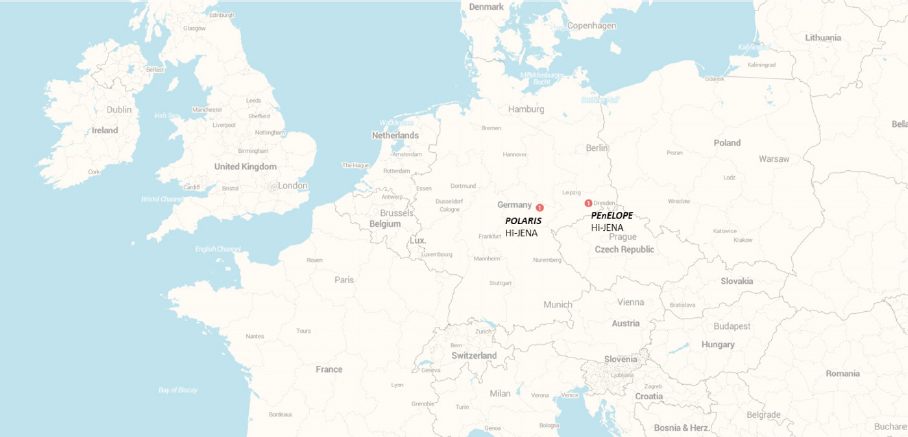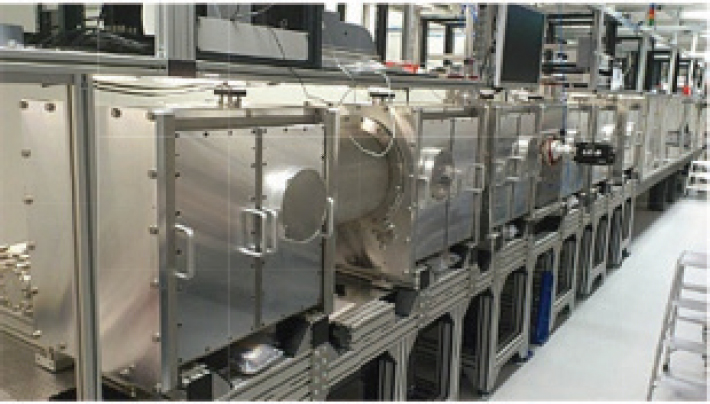E
Petawatt-Class Lasers Summary
This appendix summarizes the state of petawatt-class lasers around the world and is a provided as an informative supplement to Chapter 4.
APPENDIX E1 ND:GLASS PETAWATT-CLASS LASERS
The multi-kJ petawatt beamlines have all been primarily built to give advanced X-ray radiography capability to megajoule-class long pulse interaction facilities. They typically operate at a pulsewidth of 10 ps with multi-kJ energy outputs. The beamlines are also used for fast-ignition experiments and as high-intensity interaction beams in their own right.
The megajoule-class lasers, although designed to operate in the nanosecond regime, are true petawatt-class facilities due to their enormous scale. The multi-pass technology allows close packing of the beamlines at large aperture, producing a multi-pass stacked laser architecture. They were originally designed jointly between the United States and France for use on NIF and Laser Mégajoule (LMJ)1 and are now replicated throughout the world. (See Figure E.1 and Table E.1)
___________________
1 J.L. Miquel, 2016, LMJ & PETAL status and first experiments, J. Phys.: Conf. Ser. 717(1): 012084.
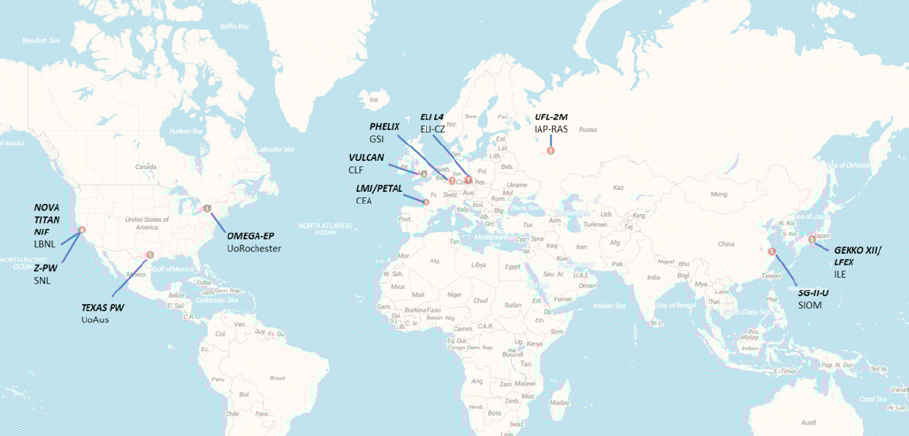
E1.1 Facilities Descriptions
Europe
The Vulcan laser system2 has been operational for over 30 years, operating within the petawatt regime since 2002. Having opened to the international plasma physics community 2 years later, currently Vulcan remains the longest-running dedicated user facility at petawatt-class. The system consists of an OPCPA front end leading toward a high-power Nd:glass main amplifier. This produces pulses at 500 J in a pulsewidth of 500 fs; an intensity of 1021 W/cm2 is incident on Vulcan’s petawatt target area. (See Figure E.2)
Orion3 became operational in April 2013 at AWE in south England. It is a Nd:glass laser system with a short-pulse petawatt beamline operating within the same regime as Vulcan. In addition to defense research, the facility has also published research in inertial confinement fusion and astrophysics.
___________________
2 C.N. Danson, P.A. Brummitt, R.J. Clarke, J.L. Collier, B. Fell, A.J. Frackiewicz, S. Hancock, S. Hawkes, C. Hernandez-Gomez, and P. Holligan, 2004, Vulcan Petawatt—an ultra-high-intensity interaction facility, Nuclear Fusion 44(12): 239–246.
3 N. Hopps, K. Oades, J. Andrew, C. Brown, G. Cooper, C. Danson, S. Daykin, S. Duffield, R. Edwards, and D. Egan, 2015, Comprehensive description of the Orion laser facility, Plasma Physics and Controlled Fusion 57(6): 064002; N. Stuart, T. Robinson, D. Hillier, N. Hopps, B. Parry, I. Musgrave, G. Nersisyan, A. Sharba, M. Zepf, and R. A. Smith, 2016, Comparative study on the temporal contrast of femtosecond mode-locked laser oscillators Opt. Lett. 41(14): 3221-3224.
TABLE E.1 Summary of the Operational, Under Construction, and Proposed Glass-Based PW-Class Lasers in the Worlda
| System Name | Operating Facility | Location | Energy (J) | Pulsewidth (fs) | Peak Power (PW) | Date Operational | Rep Rate (Hz) |
|---|---|---|---|---|---|---|---|
| Glass systems | |||||||
| Nova | LLNL | Livermore, USA | 660 | 440 | 1.5 | 1996 | Single-Shot |
| Vulcan | CLF, STFC | Oxford, UK | 500 | 500 | 1 | 2002 | Single-Shot |
| GekkoXII | ILE | Osaka, Japan | 420 | 470 | 0.89 | 2003 | Single-Shot |
| Titan | LLNL | Livermore, USA | 300 | 400 | 0.75 | 2007 | 2/hr |
| Z-Petawatt | SNL | Sandia, USA | 500 | 500 | 1 | 2010 | Single-Shot |
| Texas Petawatt Laser | Univeristy of Texas, Austin | Austin, USA | 186 | 167 | 1.11 | 2010 | Single-Shot |
| PHELIX | GSI, LLNL,CEA | Darmstadt, Germany | 400 | 350 | 1.14 | 2016 | Single-Shot |
| SG-II-U (PW) | SIOM | Shanghai, China | 1000 | 1000 | 1 | 2010 | Single-Shot |
| Orion | AWE | Aldermaston, UK | 500 | 500 | 1 | 2013 | Single-Shot |
| Omega EP | LLE, UoRochester | Rochester, USA | 1000 | 1000 | 1 | 2008 | Single-Shot |
| PETAL | CEA | Bordeaux, France | 3500 | 500 | 7 | 2015 | Single-Shot |
| LFEX | ILE | Osaka, Japan | 50000 | 10000 | 5 | 2015 | Single-Shot |
| ELI-Beamlines L4 | ELI | Prague, Czech Republic | 1500 | 150 | 10 | 2018 | 1/min |
| Megajoule lasers | |||||||
| NIF | LLNL | Livermore, USA | 1.80E+06 | 3.60E+06 | 0.5 | 2009 | Single-Shot |
| LMJ | CEA | Bordeaux, France | 1.80E+06 | 3.00E+06 | 0.6 | 2020 | Single-Shot |
| UFL-2M - IR | IAP RAS | Nizhny Novgorod, Russia | 4.60E+06 | 3.00E+06 | 1.53 | TBD | Single-Shot |
| SG-IV | SIOM | Mianyang, China | 1.80E+06 | 3.00E+06 | 0.6 | TBD | Single-Shot |
aThe summary includes PW-class lasers with a peak power > 0.5 PW, which are currently operational, under construction (i.e., funded), or proposed (i.e., unfunded). Aspirational systems for which there is no published design or tender have been omitted.
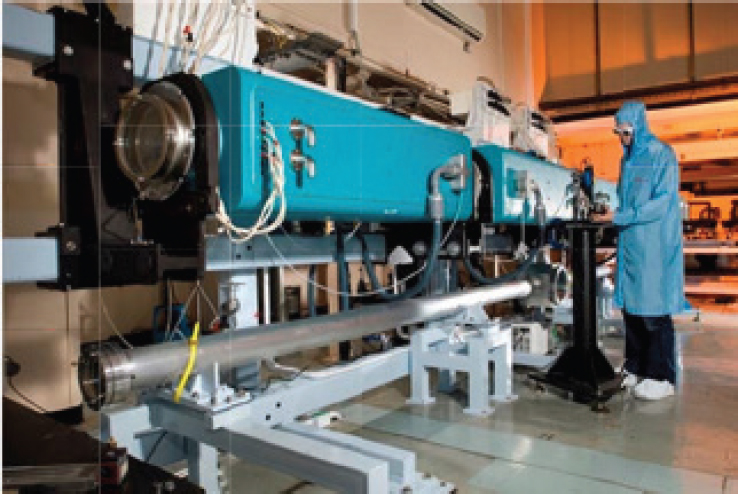
Petawatt High Energy Laser for heavy Ion eXperiments (PHELIX)4 was constructed at the Helmholtz Center GSI as a collaboration between LLNL and the Commissariat à l’Energie Atomique (CEA). Currently producing 250 J pulses of 400 fs, a planned upgrade for the laser is designed to deliver pulses of over 1 petawatt at 400 J in 350 fs. The facility is expected to produce high temporal contrast of 10–12. The upgraded laser is planned to be integrated into the Helmholtz beamline at the Facility for Antiproton and Ion Research (FAIR), providing a high repetition rate ion beam source.5
The ELI is currently constructing a beamlines facility in the Czech Republic. Beamlines L4 is estimated to complete construction in 2018.6 The goal for this system is to produce 1.5 kJ pulses within 150 fs. At completion, this 10 PW pulse will represent the highest achieved peak power of any glass system. In addition, its
___________________
4 T. Kuehl, 2014, “GSI PHELIX (Petawatt High Energy Laser for heavy-Ion eXperiments),” presented at IZEST–ELI-NP “Extreme Light’s New Horizons” Conference, Paris, Sept. 17-19.
5 Helmholtz Association, 2011, Helmholtz-Roadmap for Research Infrastructures, https://www.helmholtz.de/fileadmin/user_upload/publikationen/pdf/11_Helmholtz_Roadmap_EN_WEB.pdf.
6 G. A. Mourou, G. Korn, W. Sandner, and J.L. Collier, 2011, ELI WHITEBOOK, Berlin, THOSS Media GmbH.
projected focused intensity of 1024 W/cm2 would be greater than contemporary facilities by at least an order of magnitude.
LMJ is currently under construction in CESTA, Bordeaux.7 The facility, operated by the French Alternative Energies and Atomic Energy Commission (CEA), houses a number of lasers primarily focused on ICF PETawatt Aquitaine Laser (PETAL) functions. In addition to the main beamlines, it is able to supply pulses around 1 kJ in the region of 0.5 ps to 10 ps. The beam is designed to work synchronously with the main LMJ beamlines; its primary function will therefore likely be in diagnostics. PETAL was inaugurated in September 2015, producing 1.2 PW pulses at 840 J in 700 fs. It is expected to open to users in 2017. An upgrade for the beamline ultimately aims to increase pulse energy to 6 kJ. Operations combining the LMJ and PETAL are slated for this year.
The main megajoule component of the LMJ currently incorporates 22 beamlines divided into 176 beams traveling to the target chamber. There the light is converted into UV via frequency conversion to the third harmonic (3ω- 351 nm). The first operations at the LMJ began in 2014 with now several preliminary campaigns. LMJ is currently in the process of being upgraded—initially to 1.4 MJ operation—using the installed 176 beamlines. The final design of the facility includes 240 long-pulse beams arranged in 30 lines of eight beams. This corresponds to 1.8 MJ on target at 3ω. (See Figure E.3)
In Russia, there are plans to construct a megajoule facility, UFL-2M.8 The Institute of Applied Physics of the Russian Academy of Science (IAP RAS) based in Nizhny Novgorod, Russia, began construction early in 2012. This facility plans to combine 192 laser beams (of cross-sectional area 400×400 mm2) arranged in 48 beamlines. The facility will deliver 4.6 MJ at 1ω and 2.8 MJ at 2ω (527 nm). This facility, again, is aimed at research surrounding ICF. The peak power of the system, over 1.5 PW, is the greatest of any other planned megajoule facility.
North America
The Nova facility9 was the first petawatt-class laser system to become operational. Based at LLNL, the beamline was capable of delivering 660 J in a 440 fs pulse corresponding to peak powers of 1.5 PW and intensities of 7 × 1020 W/cm2. Nova was dismantled in 1999 for the facility to incorporate NIF.
___________________
7 J.L. Miquel, 2016, LMJ & PETAL status and first experiments.
8 V.B. Rozanov, S.Y. Gus’kov, G.A. Vergunova, N.N. Demchenko, R.V. Stepanov, I.Y. Doskoch, R. A. Yakhin, and N.V. Zmitrenko, 2016, Direct drive targets for the megajoule facility UFL-2M, J. Phys.: Conf. Ser. 688(1): 012095.
9 M.D. Perry, D. Pennington, B.C. Stuart, G. Tietbohl, J.A. Britten, C. Brown, S. Herman, et al., 1999, Petawatt laser pulses, Optics Letters 24(3): 160-162.
Titan10 is one of the five lasers that make up the Jupiter Laser Facility at LLNL. The Jupiter facility uses several beamlines to investigate laser-matter interaction. Titan is a two beam, petawatt-class laser coupled to a kJ beamline. Recently the front end of the system has been updated to an OPCPA seed pulse. Titan’s short pulse beamline delivers up to 0.75 PW in a sub-picosecond pulse as well as a 50 J, 2ω option with average contrast to the order of 10-5.
Many petawatt-class lasers play a heavy role in particle acceleration; this is especially true of the Z-Petawatt.11 This facility uses enhanced photon radiography to study high energy density events created by z-pinch accelerated X-rays. Originally constructed at LLNL but later moved to Sandia National Laboratory (SNL),
___________________
10 P.K. Patel, 2006, “Titan Laser Jupiter Laser Facility,” presented at the Fusion Science Center Meeting, Livermore, Calif., Aug. 28-29.
11 J. Schwarz, P. Rambo, M. Geissel, A. Edens, I. Smith, E. Brambrink, M. Kimmel, and B. Atherton, 2008, Activation of the Z-petawatt laser at Sandia National Laboratories, J. Phys.: Conf. Ser. 112: 032020.
Z-Petawatt was active at 100 TW in 2008 and reached petawatt-class in 2010. The combination of an OPCPA front end and Nd:phosphate glass amplifiers produces pulses of 500 J within 500 fs.
The Texas Petawatt Laser12 based at the Center for High Energy Density Science at the University of Texas at Austin uses a high energy OPCPA front end with optimized mixed glass to produce shorter pulses than traditional glass petawatt facilities—186 J in 167 fs. The Texas Petawatt has accelerated electrons up to energies of 7 GeV. (See Figure E.4)
Omega Extended Performance (EP)13 was inaugurated as the first operational multi-kJ petawatt-class facility in 2008 at the Laboratory for Laser Energetics (LLE) at the University of Rochester. The laser was built for development of fast ignition ICF and therefore couples high pulse energy, high intensity, and a short pulse length. The facility is based upon four beamlines, two of which operate for short pulses. In combination with the OMEGA beamlines, a highly flexible array of outputs is possible, delivering 1 PW performance at 1 ps and up to 6.5 kJ performance at pulsewidths >10 ps. The output is also configurable to 3ω light.
NIF,14 at LLNL, is dedicated to development of pathways toward commercial ICF. The beamlines were first opened in March 2009, and NIF is currently the only operational megajoule-scale facility. The facility delivers 192 40 × 40 beams to target. Since January 2013, NIF has been capable of delivering energy over 1.8 MJ in long pulses of 3.6 ns. This represents pulses of 3ω light at 0.5 PW. Recently, NIF published results claiming positive energy output from fusion interaction.15,16 (See Figure E.5)
___________________
12 E.W. Gaul, M. Martinez, J. Blakeney, A. Jochmann, M. Ringuette, D. Hammond, T. Borger, et al., 2010, Demonstration of a 1.1 petawatt laser based on a hybrid optical parametric chirped pulse amplification/mixed Nd:glass amplifier, Appl. Opt. 49(9): 1676-1681.
13 D.N. Maywar, J.H. Kelly, L.J. Waxer, S.F.B. Morse, I.A. Begishev, J. Bromage, C. Dorrer, J.L. Edwards, L. Folnsbee, and M.J. Guardalben, 2008, OMEGA EP high-energy petawatt laser: progress and prospects, Journal of Physics: Conference Series 112(3): 032007.
14 L.J. Perkins, R. Betti, K.N. LaFortune, and W.H. Williams, 2009, Shock ignition: A new approach to high gain inertial confinement fusion on the National Ignition Facility, Phys. Rev. Lett. 103: 045004; E.I. Moses, J. Atherton, L. Lagin, D. Larson, C. Keane, B. MacGowan, R. Patterson, M. Spaeth, B. Van Wonterghem, P. Wegner, and R. Kauffman, 2016, The National Ignition Facility: Transition to a user facility, Journal of Physics: Conference Series 688(1); E.I. Moses and the NIC Collaborators, 2013, The National Ignition Campaign: status and progress, Nuclear Fusion 53(10): 104020.
15 R. Betti and O. A. Hurricane, “Inertial-Confinement Fusion with Lasers,” Nature Physics, May 3, 2016, 435–48, doi:10.1038/nphys3736.
16 O. A. Hurricane et al., “Fuel Gain Exceeding Unity in an Inertially Confined Fusion Implosion,” Nature 506, no. 7488 (February 20, 2014): 343–48, doi:10.1038/nature13008.
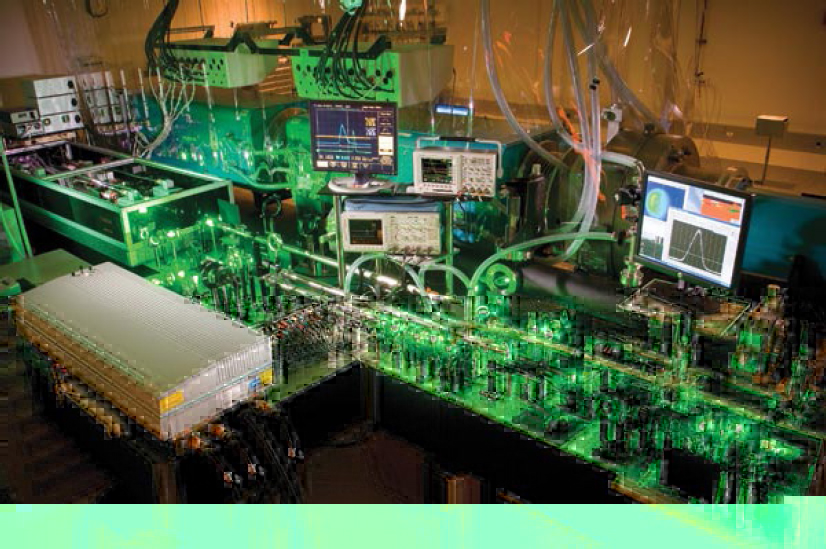
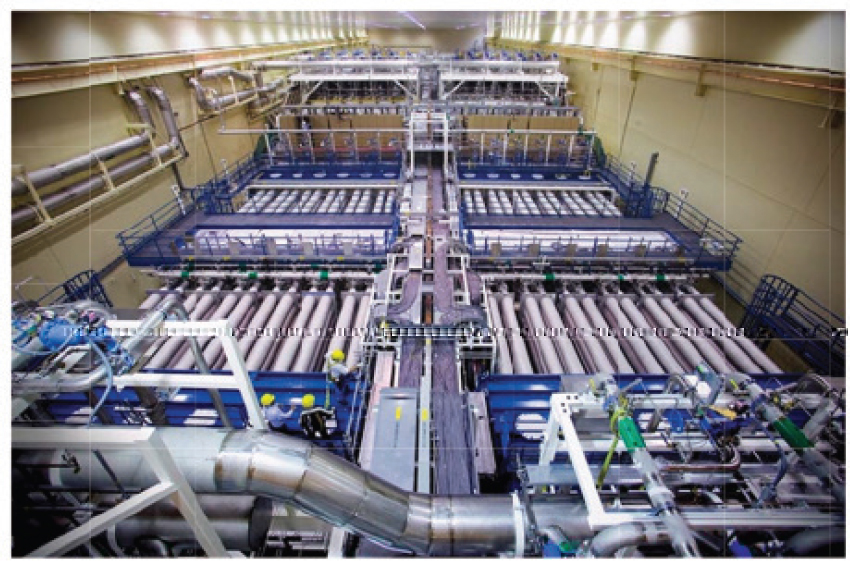
Asia
Gekko XII17 was the first petawatt-class system constructed in Asia and has been operational since 2003 at the Institute of Laser Engineering (ILE), University of Osaka, Japan. Consisting of an OPCPA front end and 12 Nd:Glass amplified beamlines, it produces 2ω ultra-short pulses of 420 J in a 470 fs. Similar to many lasers operating in this application space, Gekko XII primarily researches fast ignition for ICF. An F/7 off-axis parabola was used to focus to target, giving focused intensities of 2.5×1019 W/cm2 with contrast levels of 1:5×108 W/cm2.
Also based at the Gekko XII facility is the laser for fast ignition experiment (LFEX),18 a mutli-petawatt laser operational at high peak powers. LFEX, in addition to Gekko, makes up the fast ignition realization experiment (FIREX) project for research into fast ignition. The system is currently used in fast X-ray generation. In 2015 it published results of operation at 2 PW, the highest peak power of any system at that time. LFEX is under ongoing upgrades with the final goal of producing 5 PW pulses with an input energy of 50 kJ. The beam is focused to target by a 4 m off-axis parabola. The contrast of the final specification will be to the order of 1010.
The Shanghai Institute of Optics and Fine Mechanics (SIOM) is responsible for the operation of several petawatt-class lasers. SIOM currently houses the highest power, cumulatively, of any major facility worldwide. The first operational petawatt-class system was SG-II,19 the Shenguang (Divine Light) II high energy facility. SG-II was an eight beam Nd:glass laser facility producing long pulses at an energy of 6 kJ with a 2 kJ option at 3ω. A ninth beamline, commissioned in 2005, was later converted to the SG-II-U PW20 beamline in 2010. In the petawatt regime, SG-II-U outputs 1 kJ pulses in 1 ps. SG-II-U also included the building of a separate 24 kJ, 3ω, 3 ns eight-beam facility. SG-II is currently being refitted as a fully OPCPA system. This will be discussed further in a later section.
SIOM currently plans to begin production of another megajoule laser, SG-IV.21 The system is to be built at the Chinese Academy of Engineering Physics (CAEP)
___________________
17 T. Yamanaka, H. Azechi, Y. Fujimoto, H. Fujita, Y. Izawa, T. Jitsuno, Y. Kitagawa, et al., 2002, “Progress in Direct-Drive Laser Fusion UsingXII/PW Facility,” presented at the 19th Fusion Energy Conference, Lyon, France, Oct. 14-19.
18 H. Azechi and FIREX Project Team, 2016, The status of Fast Ignition Realization EXperiment (FIREX) and prospects for inertial fusion energy, J. Phys.: Conf. Ser. 717: 012006.
19 Z. Lin, X. Deng, D. Fan, and X. Xie, 1999, SG-II laser elementary research and precision SG-II program, Fusion Engineering and Design 44(1–4): 61-66.
20 G. Xu, T. Wang, Z. Li, and J. Zhu, 2008, 1 kJ petawatt laser system for SG-II-U program, The Review of Laser Engineering 36(APLS): 1172-1175; T. Wang, G. Xu, Y. Dai, Z. Lin, and J. Zhu, 2011, Recent progress on the PW beamline for SG-II-U laser facility, Pp. 1-2 in CLEO: 2011- Laser Science to Photonic Applications, Baltimore, Md., May 1-6.
21 X.T. He and ICF teams in China, 2016, The updated advancements of inertial confinement fusion program in China, Journal of Physics: Conference Series 688: 012029.
Research Center for Laser Fusion, Mianyang, China. Although the design of the system has not been finalized, it is believed to operate within a similar scale to NIF and LMJ. Design options can be tested on SG-IIIP, a prototype beamline contained within SG-III.
APPENDIX E2 TI:SAPPHIRE PETAWATT-CLASS LASERS
The following section describes in brief the major facilities worldwide that house Ti:Sapphire-based petawatt-class lasers. In recent years, advances in technology have sufficiently reduced the scale and cost of high power Ti:Sapphire lasers such that commercial systems operating up to ~300 TW are within reach of university departments from companies such as Amplitude Technologies and Thales. This section will focus primarily on systems that can deliver > 0.5 PW on target.
Ti:Sapphire-based systems are not limited to the single PW level. The highest peak power Ti:Sapphire system in development at present is Apollon, which has recently demonstrated 5 PW peak power with a target of 10 PW.22 Similarly, SIOM is currently constructing a 10 PW laser also currently operational at 5 PW23 and the ELI-Nuclear Physics (NP) Facility has commissioned 2 x 10 PW systems commercially.24 However, to achieve such high peak powers, these laser facilities must operate at lower repetition rates (<1 shot/min). (See Figure E.6)
Table E.2 provides a comparison of all 22 PW-class Ti:Sapphire lasers currently in operation, under construction, or planned. This presents a statistical overview of > 0.5 PW Ti:Sapphire-based lasers worldwide. Each laser system has been represented by the factors most pertinent to the intended applications of a PW-class Ti:Sapphire system.
E2.1 Facilities Descriptions
Europe
Operational since 2008, Gemini25 is one of the CLF’s flagship lasers and has been accessible to the academic and industrial user communities for many years.
___________________
22 J.P. Zou, C. Le Blanc, D.N. Papadopoulos, G. Chériaux, P. Georges, G. Mennerat, F. Druon, et al., 2015, Design and current progress of the Apollon 10 PW project, High Power Laser Science and Engineering 3: e2; F. Giambruno, C. Radier, G. Rey, and G. Chériaux, 2011, Design of a 10 PW (150 J/15 fs) peak power laser system with Ti:sapphire medium through spectral control, Applied Optics 50(17): 2617-2621; École Polytechnique, “Birth of Apollon, the Most Powerful Laser Worldwide,” last update September 30, 2015, https://www.polytechnique.edu/en/content/birth-apollon-most-powerful-laser-worldwide?language=en.
23 Y. Chu. Z. Gan, X. Liang, L. Yu, X. Lu, C. Wang, X. Wang, et al, 2015, High-energy large-aperture Ti:sapphire amplifier for 5 PW laser pulses, Optics Letters 40(21): 5011-5014.
24 F. Lureau, S. Laux, O. Casagrande, O. Chalus, P.A. Duvochelle, S. Herriot, C. Radier, et al., 2015, Design and initial results of 10 PW Laser for ELI-NP, presented at the 2015 European Conference on Lasers and Electro-Optics, Munich, Germany, June 21-25, Optical Society of America.
25 C.J. Hooker, J.L. Collier, O. Chekhlov, R. Clarke, E. Divall, K. Ertel, B. Fell, et al., 2006, The Astra Gemini Project—A dual-beam petawatt Ti:Sapphire laser system, J. Phys. IV 133: 673-677.

It has two beamlines, each delivering 15 J of energy in 30 fs pulses, providing dual 0.5 PW beams to target at a pulse repetition rate of 0.05 Hz. (See Figure E.7)
Additionally, a planned upgrade to the Gemini system is scheduled to be completed by 2019. Gemini 2PW would be capable of producing 60 J, 30 fs pulses at the same repetition rate as its predecessor.
PULSAR will be operational in 2019 and will operate up to 1 PW peak power in a 30 fs pulse at 10 Hz repetition rate. The proposed picosecond upgrade to the DiPOLE pump laser will be operational following PULSAR and further expand the research capabilities of this exciting new system.
APOLLON is a laser system under development at École Polytechnique, Paris, in partnership with Centre Nationnal de la Recherche Scientifique (CNRS) and CEA.26 The laser, consisting of an OPCPA front end driving a Ti:Sapphire main amplifier, is predicted to become operational at 5 PW mode, providing 75 J in 15 fs, later this year. Apollon works in a single-shot mode; however, it is capable of producing one shot every minute. The laser currently produces focused intensities of 1022 W/cm2. Apollon will be used, in part, for particle acceleration research, able to generate beams of protons or electrons at relativistic speeds close to the speed of light.
___________________
26 J.P. Zou, et al., 2015, Design and current progress of the Apollon 10 PW project; F. Giambruno, et al., 2011, Design of a 10 PW (150 J/15 fs) peak power laser system; École Polytechnique, 2015, Birth of Apollon.
TABLE E.2 Summary of the Operational, Under Construction, and Proposed Ti:Sapphire-Based PW-Class Lasers in the Worlda
| System Name | Operating Facility | Location | Energy (J) | Pulsewidth (fs) | Peak Power (PW) | Date Operational | Rep Rate (Hz) |
|---|---|---|---|---|---|---|---|
| Ti:S systems | |||||||
| Ti:Sapp 10Hz | CLF, STFC | Oxford, UK | 30 | 30 | 1 | TBD | 10 |
| ELI-L3/ HAPLS | LLNL, ELI | Prague, Czech Republic | 30 | 30 | 1 | 2018 | 10 |
| VEGA-3 | CLPU | Salamanca, Spain | 30 | 30 | 1 | 2018 | 1 |
| Atlas 3000 | CALA, MPQ | Munich, Germany | 60 | 20 | 3 | 2017 | 1 |
| CETAL PW | CETAL, Thales | Bucharest, Romania | 25 | 25 | 1 | 2016 | 0.1 |
| J-KAREN | JAEA | Kyoto, Japan | 30 | 30 | 1 | 2003 | Single-Shot |
| J-KAREN-P | JAEA | Kyoto, Japan | 38.5 | 30 | 1.28 | 2014 | 0.1 |
| DRACO | HZDR, Amplitude | Dresden, Germany | 30 | 30 | 1 | 2013 | 1 |
| PULSER II | APRI | Gwangju, South Korea | 44.5 | 30.2 | 1.47 | 2012 | 0.1 |
| PULSER I | APRI | Gwangju, South Korea | 34 | 30 | 1.13 | 2010 | 0.1 |
| BELLA | Berkeley Lab | Berkeley, USA | 42 | 30 | 1.4 | 2012 | 1 |
| Diocles | Extreme Light Laboratory | U. Neb., Lincoln, USA | 30 | 30 | 1 | 2012 | 0.1 |
| Laserix | CLUPS | Paris, France | 40 | 50 | 0.8 | 2011 | 0.1 |
| Gemini 2 PW | CLF, STFC | Oxford, UK | 60 | 30 | 2 | 2019 | 0.05 |
| Gemini | CLF, STFC | Oxford, UK | 15 | 30 | 0.5 | 2008 | 0.05 |
| ALLS | INRS | Canada | 10 | 20 | 0.5 | 2008 | 2.5 |
| SIOM Ti:S CPA | SIOM, Amplitude | Shanghai, China | 138.5 | 27 | 5.13 | 2015 | 1/min |
| XL-III | IPhys | Beijing, China | 32.3 | 27.9 | 1.16 | 2011 | 0.05 |
| OPCPA/ Ti:S hybrid lasers | |||||||
| Apollon | CILEX | Paris, France | 150 | 15 | 10 | 2018 | 1/min |
| ELI-ALPS | ELI | Budapest, Hungary | 40 | 15 | 2.67 | 2018?? | <5 |
| ELI-NP [1] | ELI | Romania | 15 | 15 | 1 | 2018 | 0.1 |
| ELI-NP [2] | ELI | Romania | 150 | 15 | 10 | 2018 | 1/min |
aThe summary includes PW-class lasers with a peak power > 0.5 PW and a repetition rate > 0.05 Hz.
SOURCE: J. Collier, Rutherford Central Laser Facility.
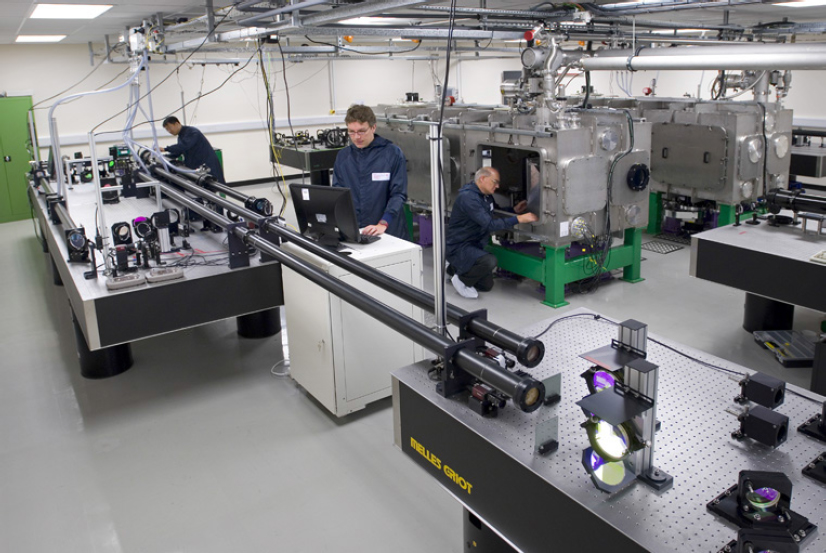
ELI Beamlines L327 is currently under development by LLNL, pumped by the High-Repetition-Rate Advanced Petawatt Laser System (HAPLS). It will purportedly offer 30 J pulses with a pulse length of 30 fs. Due to the diode-pumped architecture of the system, the laser will operate at a repetition rate of 10 Hz.
LLNL is providing ELI Beamlines with the uncompressed laser, and ELI Beamlines will integrate with its own pulse compressor.
ELI- Attosecond Light Pulse Source (ALPS),28 ELI’s attosecond facility, will house two main petawatt-class beamlines. Each is intended for production of ultrashort attosecond regime pulses. The first is a high repetition rate laser capable of producing pulses approaching 3 PW, with the pulse length confined to within 15 fs. Secondly, a 10 PW beamline will provide high energy pulses in a 30 fs pulsewidth. ELI-ALPS beamlines will be used to drive secondary sources at a variety of targets.
ELI-NP29 will employ dual beamlines with OPCPA front ends and Ti:sapphire-power amplifiers. The beamlines, based upon the design of APOLLON, will pro-
___________________
27 Rus, P. Bakule, D. Kramer, G. Korn, J.T. Gren, J. Novak, M. Fibrich, et al., 2013, ELI-Beamlines laser systems: status and design options, Proc. SPIE 8780: 87801T.
28 G.A. Mourou, et al., 2011, ELI WHITEBOOK.
29 F. Lureau, et al., 2015, Design and initial results of 10 PW Laser for ELI-NP.
duce 10 PW pulses at 1 shot per minute. In addition, a 1 PW mode, 15 J in 15 fs, of the lasers will operate at a 1 Hz rep rate. The beamlines will drive gamma sources for analyzing nuclear science.
The University of Munich’s Atlas-300030 is a high intensity, high peak power system developed by Centre for Advanced Laser Applications (CALA). It is under construction for operation in 2017. The system, whose final amplifier is supplied by Thales, will be capable of shots at a repetition rate of 1 Hz, energy of 60 J, and a pulsewidth within 20 fs. It is intended for use in particle acceleration research as well as medical science, in particular cancer research. (See Figure E.8)
The second Thales system, under construction at the Centre for Advanced Laser Technologies National Institute for Laser, Plasma, and Radiation Physics (INFLPR), Romania, is the CETAL Petawatt laser (25 J in 25 fs).31 The facility will operate at a repetition rate of 0.1 Hz and be operational later this year. CETAL will be used to investigate areas such a photonics, high field laser physics, and materials processing.
The LASERIX facility32 at the University Paris Sud, France, was designed to be a high-repetition-rate multi-beam laser to pump an XUV laser. The laser was a combination of commercially supplied sub-systems primarily from Thales Laser for the front-end systems, Amplitude Technologies for the power amplification, and Quantel for the Nd:glass pump laser. The laser performance was first demonstrated in 2006, delivering 36 J of energy without full compression. The published operational capability is 40 J in a 50 fs pulse duration producing a peak power of 0.8 PW and an operational repetition rate of 0.1 Hz. The facility is in the process of being moved to Centre Interdisciplinaire Lumiere Extreme (CILEX).
Dresden laser acceleration source (DRACO)33at the Helmholtz-Zentrum Dresden-Rossendorf laboratory (HZDR) in Germany is a commercially sourced system from Amplitude Technologies. This is an extension to Amplitude’s commercial 200 TW PULSAR system, named PULSAR PW. The facility is designed to investigate electron, ion, and proton acceleration schemes for radiation therapy as part of Electron Linac for beams with high Brilliance and low Emittance (ELBE)– Center for High Power Radiation Sources. The system currently operates at 0.75 PW, over
___________________
30 S. Karsch, 2011, “CALA and Garching Plans,” presented at the European Network for Novel Accelerators Workshop, Geneva, May 3-6.
31 Center for Advanced Laser Technologies, “CETAL-PW Laboratory,” www.cetal.inflpr.ro/cetal-pw, accessed January 30, 2017.
32 D. Ros, K. Cassou, B. Cros, S. Daboussi, J. Demailly, O. Guilbaud, G. Jamelot, et al., 2011, LASERIX: An open facility for developments of EUV and soft X-ray lasers and applications, Nucl. Instr. Meth. Phys. Res. A 653: 76-79.
33 Helmholtz-Zentrum Dresden-Rossendorf, “Petawatt Laser DRACO,” hzdr.de/db/ Cms?pNid=2096, last update February 2, 2016; U. Schramm and S. Bock, 2013, “Status of Draco PW,” presented at the Characterisation of Ultra-Short High Energy Laser Pulses Workshop, Abingdon, UK, Sept. 23-24.
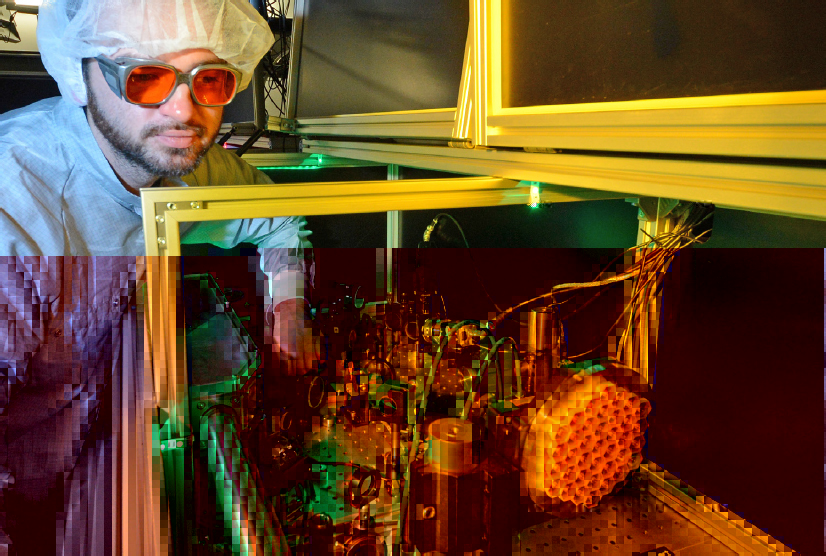
a 30 fs pulse duration at a repetition rate of 1 Hz. Due to a recent upgrade project, DRACO is expected to deliver 1 PW pulses from Fall 2016 onwards. (See Figure E.9)
Vega-3,34 another Amplitude Technologies system, is under construction in Salamanca for use by the Spanish Pulsed Lasers Centre (CLPU). The system is constituted of three beamlines, the first two of which are currently operational. Each is able to deliver 10 Hz, 30 fs beams to targets at low peak powers. Vega-2 produces a 6 J pulse while the pulse from Vega-1 is in the millijoule range. Vega-3 is intended as a 30 J, 30 fs system with an operational repetition rate of 1 Hz. The estimated operational date for Vega-3 is 2018.
North America
The Berkeley Lab Laser Accelerator (BELLA) project35was launched in 2009 and is funded by the U.S. Department of Energy for experiments on laser plasma
___________________
34 L. Roso, 2011, Salamanca Pulsed Laser Center: the Spanish petawatt, Proc. SPIE 8001: 800113.
35 W.P. Leemans, J. Daniels, A. Deshmukh, A.J. Gonsalves, A. Magana, H.S. Mao, D.E. Mittelberger, et al., 2013, BELLA laser and operations, Pp. 1097-1100 in Proceedings of PAC2013 03(A23), paper THYAA1.
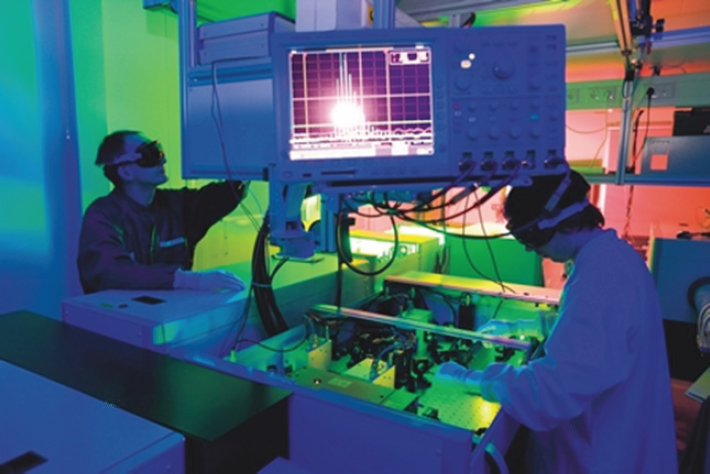
acceleration at the Lawrence Berkeley National Laboratory (LBNL). BELLA was commercially built and delivered to LBNL by Thales in 2012. It can operate at peak power levels of 1.3 PW with a 42 J, and 30 fs pulse. BELLA was the first PW class system capable of operating at a repetition rate of 1 Hz. (See Figure E.10)
The Diocles laser36 at the Extreme Light Laboratory, University of Nebraska–Lincoln is a flashlamp pumped system that produces 30 J in 30 fs and can provide 1 PW at 0.1 Hz to target. It was commissioned in 2012 and is used in the study of plasma physics. (See Figure E.11)
The Advanced Laser Light Source (ALLS)37 is based at Institut National de la Recherche Scientifique (INRS) near Montreal. The most powerful laser in Canada, the system produces ultra-short pulses at a peak power of 0.5 PW. Each pulse is 10 J, 20 fs at a repetition rate of 2.5 Hz. This laser is capable of producing pulses in a range of wavelengths, from infrared to X-ray.
___________________
36 C. Liu, S. Banerjee, J. Zhang, S. Chen, K. Brown, J. Mills, N. Powers, B. Zhao, G. Golovin, I. Ghebregziabher, and D. Umstadter, 2013, Repetitive petawatt-class laser with near-diffraction-limited focal spot and transform-limited pulse duration, Proc. SPIE 8599: 859919.
37 Advanced Laser Light Source, Canada, “Specialized Labs and Equipment.”
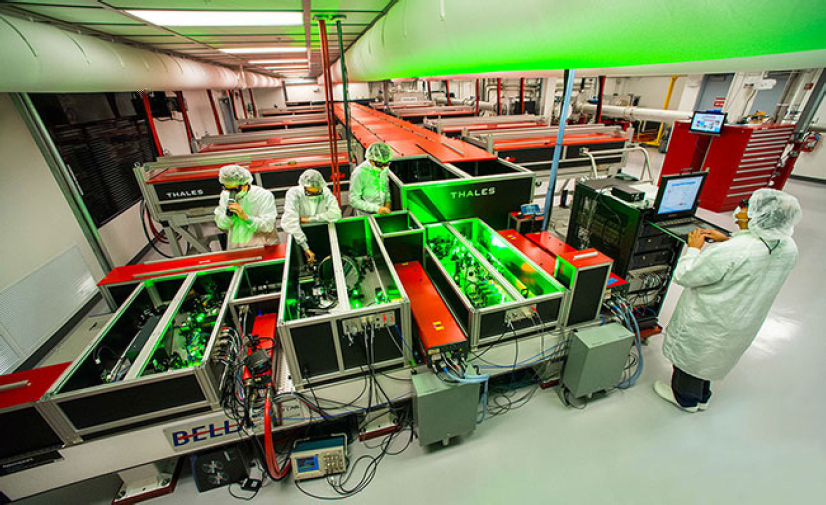

Asia
The Japan-Kansai Advanced Relativistic Engineering (J-KAREN)38 laser system constructed at the Kansai Photon Science Institute, National Institutes for Quantum and Radiological Science and Technology (QST), Kyoto, Japan, was the world’s first petawatt-class Ti:Sapphire facility. In 2003, the facility was generating 20 J at 33 fs, giving 0.85 PW but in single shot operation. Its upgrade, J-KAREN-P, became operational in April 2014.39 This laser increased the pulse energy to 38.5 J, resulting in a peak power of 1.3 PW at an improved repletion rate of 0.1 Hz.
The Advanced Photonics Research Institute (APRI), Gwangju Institute of Science and Technology (GIST) in South Korea currently houses two PW-class beam lines, known as PULSER I and PULSER II.40 PULSER I was completed in 2010 and was capable of generating a 33 J beam in 30 fs, delivering 1.1 PW at a repetition rate of 0.1 Hz and is claimed to be the very first 0.1 Hz Ti:sapphire petawatt laser in the world. Two years later, the facility was upgraded to include the PULSER II beamline which delivers 1.5 PW to target, still at a repetition rate of 0.1 Hz. The next planned upgrade for the PULSER II laser will enhance the energy to 80 J while reducing the pulse duration to 20 fs. This will allow it to operate with a peak power of 4 PW but at a much reduced repetition rate.
The XL-III laser facility41 is a laser operated by the Chinese Academy of Sciences. The facility runs a number of femtosecond pulse length lasers, the foremost of these producing 1.16 PW pulses. The first experiments with the XL-III facility were carried out in 2006 with a 350 TW beamline. The facility was expanded in 2011 to include an OPCPA-Ti:Sapphire hybrid laser capable of 33 J, 28 fs pulses.
The SIOM Ti:Sapphire CPA laser is based at the XG-III (Qiangguang- High light) laser facility. A paper in 2013 published results of the laser working at 2 PW, 52.3 J in 26 fs.42 There are plans to increase functionality to 5 PW, almost tripling the beam energy. The laser is used for particle acceleration experiments but is also intended to use frequency doubled light to pump an OPCPA system built at the same facility.
___________________
38 M. Aoyama, K. Yamakawa, Y. Akahane, J. Ma, N. Inoue, H. Ueda, and H. Kiriyama, 2003, 0.85-PW, 33-fs Ti:sapphire laser, Opt. Lett. 28(17): 1594-1596.
39 H. Kiriyama, M. Mori, A. Pirozhkov, K. Ogura, M. Nishiuchi, M. Kando, H. Sakaki, et al., 2015, Recent advances on the J-KAREN laser upgrade, in CLEO: 2015, San Jose, Calif., May 10-15, Optical Society of America.
40 T.M. Jeong and J. Lee, 2014, Femtosecond petawatt laser, Annalen der Physik 526(3-4): 157-172.
41 Z. Wang, C. Liu, Z. Shen, Q. Zhang, H. Teng, and Z. Wei, 2011, High-contrast 1.16 PW Ti:sapphire laser system combined with a doubled chirped-pulse amplification scheme and a femtosecond optical-parametric amplifier, Opt. Lett. 36(16): 3194-3196.
42 Y. Chu, et al., 2015, High-energy large-aperture Ti:sapphire amplifier.
APPENDIX E3 OPTICAL PARAMETRIC CHIRPED-PULSE AMPLIFICATION PETAWATT-CLASS LASERS
Since its initial inception in 1998,43 the OPCPA technique has undergone much development; however, at present there are a limited number of facilities around the world developing PW-class OPCPA lasers. The first such system was PEARL44 at the Luch Facility at the Institute of Applied Physics, Russian Academy of Science, Nizhny Novgorod. This is a low repetition rate system that operates at 0.56 PW. (See Figure E.12)
OPCPA-based systems are considered the best route to higher peak power systems; as a result, all of the planned systems that are in excess of 10 PW are OPCPA-based. These include OPAL (United States), XCELS (Russia), Vulcan 2020 (United Kingdom), ELI 4th Pillar (Europe), and GEKKO EXA (Japan). A full list of the operational, under construction, and planned OPCPA-based laser systems is shown in Table E.3.
E3.1 Facilities Descriptions
Europe
Plans to upgrade the Vulcan laser to full OPCPA have been submitted by the CLF.45 Originally the specifications were for 10 PW; however, this was later adjusted to 20 PW; 600 J in 30 fs. Vulcan-20PW is anticipated to be completed around 2020. The beamlines will use the existing system as a pump source for DKDP crystals, which will amplify the beam to target.
ELI Beamlines L246 is a high repetition rate, two-stage OPCPA chain laser. The pulse from the first chain is optionally pumped by a cryogenically cooled DPSSL system supplied by the CLF before heading through to the pulse compressor. The petawatt-class output from this system is 20 J in less than 15 fs at 10 Hz.
___________________
43 G. Cerullo, M. Nisoli, S. Stagira, and S. De Silvestri, 1998, Sub-8-fs pulses from an ultrabroadband optical parametric amplifier in the visible, Optics Letters 23(16): 1283-1285.
44 V.V. Lozhkarev, G.I. Freidman, V.N. Ginzburg, E.V. Katin, E.A. Khazanov, A.V. Kirsanov, G.A. Luchinin, et al., 2007, Compact 0.56 Petawatt laser system based on optical parametric chirped pulse amplification in KD*P crystal, Laser Physics Letters 4(6): 421.
45 C. Hernandez-Gomez, S.P. Blake, O. Chekhlov, R.J. Clarke, A.M. Dunne, M. Galimberti, S. Hancock, et al., 2010, The Vulcan 10PW project, Journal of Physics: Conference Series 244(3): 032006; Y. Tang, A. Lyachev, C. Hernandez-Gomez, I. Musgrave, I. N. Ross, O. Chekhlov, P. Matousek, and J. Collier, 2010, Novel ultra broadband front-end system for Vulcan 10 PW OPCPA Project, in Lasers, Sources and Related Photonic Devices, San Diego, Calif., Jan. 31-Feb. 3, Optical Society of America, paper AME1.
46 G.A. Mourou, et al., 2011, ELI WHITEBOOK.
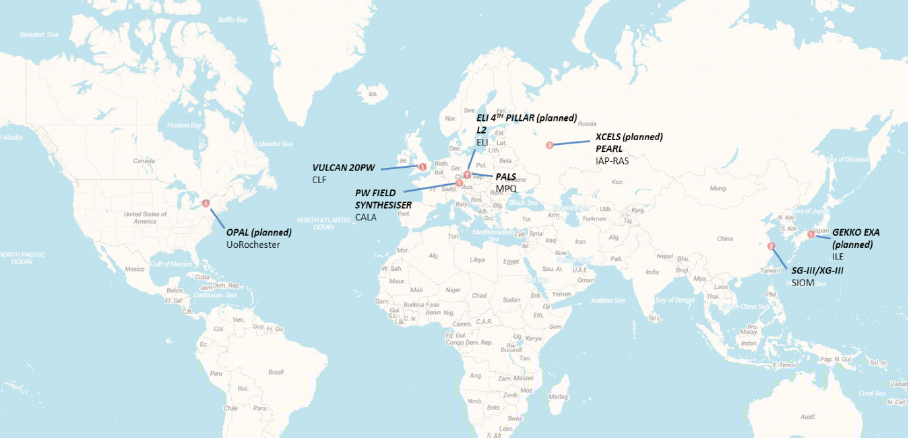
Prague Asterix Laser System (PALS)47 is a high power sub-petawatt iodine-based laser. The principle beamline of PALS is the Asterix IV system. The laser was first built at the Max-Planck-Institute (MPQ) in Garching, Germany, and completed in 1995. Asterix was subsequently moved to Prague in September 2000, becoming operational shortly thereafter. A proposed 1.4 PW upgrade has been published; however, there is not currently an estimated completion date for the project.
The Petawatt Field Synthesizer48 is under construction also at MPQ, Garching. The system is designed in order to develop attosecond pulse generation capabilities. The system consists of five OPCPA amplification stages in addition to two pulse compressors. The final system output will measure 1 PW and only 5 J, however, in an ultra-short pulse of 5 fs. The laser is expected to be operational in 2017.
ELI’s 4th Pillar is the final planned facility of the project.49 The pillar is intended for applications in ultra-high intensity research. It will provide a cumulative power output of 200 PW. Currently there is no published design or specifications for the final pillar.
___________________
47 O. Novák, M. Divoký, H. Turčičová, and P. Straka, 2013, Design of a petawatt optical parametric chirped pulse amplification upgrade of the kilojoule iodine laser PALS, Laser and Particle Beams 31(2): 211–218.
48 Z. Major, S.A. Trushin, I. Ahmad, M. Siebold, C. Wandt, S. Klingebiel, T.J. Wang, et al., 2009, Basic concepts and current status of the petawatt field synthesizer—A new approach to ultrahigh field generation, Laser Review 37(6): 431-436.
49 G.A. Mourou, et al., 2011, ELI WHITEBOOK.
TABLE E.3 Summary of the Operational, Under Construction, and Proposed Worldwide PW-Class Systems Whereby the Main Amplification Technique is OPCPA
| System Name | Operating Facility | Location | Energy (J) | Pulsewidth (fs) | Peak Power (PW) | Date Operational | Rep Rate (Hz) |
|---|---|---|---|---|---|---|---|
| OPCPA lasers | |||||||
| PEARL | IAP RAS | Nizhny Novgorod, Russia | 24 | 43 | 0.56 | 2007 | Single-Shot |
| PEARL-10 | IAP RAS | Nizhny Novgorod, Russia | 150 | 30 | 5 | 2016 | Single-Shot |
| XG-III | SIOM | Shanghai, China | 32.6 | 32 | 1.02 | 2013 | 0.05 |
| SG-II | SIOM | Shanghai, China | 150 | 30 | 5 | 2015 | Single-Shot |
| Petawatt field synthesiser | LMU, MPQ | Munich, Germany | 5 | 5 | 1 | 2017 | 10 |
| Vulcan 2020 | CLF, STFC | Oxford, UK | 600 | 30 | 20 | TBD | Single-Shot |
| ELI-Beamlines L2 | ELI | Prague, Czech Republic | 20 | 20 | 1 | TBD | 10 |
| PALS | ELI | Prague, Czech Republic | 34 | 23 | 1.48 | TBD | Single-Shot |
| OMEGA EP OPAL | LLE, UoRochester | U. Rochester, USA | 1600 | 20 | 75 | TBD | Single-Shot |
| XCELS | IAP RAS | Nizhny Novgorod, Russia | 4800 | 25 | 192 | TBD | Single-Shot |
| Gekko EXA | ILE | Osaka, Japan | 500 | 10 | 50 | TBD | Single-Shot |
| ELI 4th Pillar | ELI | TBD | 200 | TBD | Single-Shot | ||
SOURCE: J. Collier, Rutherford Central Laser Facility.
PEARL,50 the first operational fully OPCPA system was developed using a pump beam derived from the Luch Facility at the Institute of Applied Physics, Russian Academy of Science, Nizhny Novgorod. The laser was upgraded to 0.56 PW in 2007. PEARL was able to reach a focused intensity of 1022 W/cm2, which is very high for a laser of its type.
PEARL has begun to be iterated to multi-petawatt functionality. PEARL-10,51 designed to provide 10 times the power of PEARL, is currently approaching 5-PW functionality, i.e., 150 J pulses in 30 fs. The beam is pumped by three pump lasers, each amplified by a range of materials. The pump beams feed a two-stage amplifier. The current estimate is for the laser to come online by the end of this year.
A similar planned project to that of the ELI fourth pillar at the Institute of Applied Physics of the Russian Academy of Sciences in Nizhny Novgorod is the Exawatt Centre for Extreme Light Studies (XCELS).52 This megascience project in Russia is to produce an exawatt laser system for fundamental science. The system will use 12 combined 15-PW OPCPA channels, each based upon an upgraded design of the PEARL-10 PW. The combined output is specified as 200 PW.
North America
Optical Parametric Amplifier Line (OPAL)53 is the North American exawatt project. It is based at the LLE, University of Rochester. The laser is based upon a design using four OMEGA EP beamlines, each of which pumps a DKDP amplifier. The first stage of the project aims to establish a 75 PW output by 2022. After this, the output may be extended toward 200 PW giving focused intensities of 1024 W/cm2.
Asia
The SG-II facility,54 based in Shanghai and managed by SIOM, is currently being redesigned to work as a fully OPCPA system. This laser utilizes two Nd:glass
___________________
50 V.V. Lozhkarev, et al., 2007, Compact 0.56 Petawatt laser system.
51 Presentation: Exawatt Centre for Extreme Light Studies Project (XCELS) (2013).
52 Presentation: Exawatt Centre for Extreme Light Studies Project (XCELS) (2013); Institute of Applied Physics of the Russian Academy of Sciences, “Exawatt Center for Extreme Light Studies (XCELS): Project Summary,” http://www.xcels.iapras.ru/img/site-XCELS.pdf; Institute of Applied Physics of the Russian Academy of Sciences, “On the way to multipetawatt power. PEARL-10,” http://www.iapras.ru/english/science/las_phys/gen_lasf2.html, accessed January 30, 2017.
53 D.D. Meyerhofer, 2014, “OMEGA EP OPAL: A Path to a 75-PW Laser System,” presented at the 56th Annual Meeting of the American Physical Society, Division of Plasma Physics, New Orleans, La., October 27–31.
54 X. Xie, J. Zhu, Q. Yang, J. Kang, H. Zhu, A. Guo, P. Zhu, and Q. Gao, 2015, Multi petawatt laser design for the SHENGUANG II laser facility, Proc. SPIE 9513, High-Power, High-Energy, and High-Intensity Laser Technology II, Prague, Czech Republic, April 13.
pumping lasers: the SG-II main system and the ninth beam from the same facility. The system is finally amplified by three OPCPA stages, two BBO crystals and one LBO. At the beginning of 2016, outputs of 30 J in 27 fs have been recorded. The laser specification indicates a goal of 150 J in 30 fs with a repetition rate of one shot every 6 minutes. The OPCPA upgrade is expected to become operational by 2017.
Another OPCPA system developed by SIOM is a 10-PW CPA-OPCPA hybrid located in the XG-III facility.55 The system uses the high contrast of a Ti:Sapphire CPA front end to produce a stable pulse for LBO OPCPA amplification. In 2013, the system produced pulses around 28.7 J in 33.8 fs. The 10 PW (300 J in 30 fs) specification is due to be delivered in 2017.
Gekko EXA56 is the exawatt facility planned to be constructed at ILE, the University of Osaka, Japan. Design of the system started in 2010, though construction has yet to begin, and the given date of completion is in 2020. Gekko EXA is designed for flexible operation in three modes. Firstly, a high average power 1 PW beamline at a repetition rate of 100 Hz, corresponding to a high average power of 2 KW. Secondly, 20 PW operation aims to provide pulses of greater than 200 J in less than 10 fs, which will be achieved at 0.01 Hz operation. Lastly, the LFEX laser system is intended as a pump source for 50 PW single shot operations.
___________________
55 L. Xu, L. Yu, X. Liang, Y. Chu, Z. Hu, L. Ma, Y. Xu, et al., 2013, High-energy noncollinear optical parametric–chirped pulse amplification in LBO at 800 nm, Opt. Lett. 38(22): 4837-4840.
56 J. Kawanaka, K. Tsubakimoto, H. Yoshida, K. Fujioka, Y. Fujimoto, S. Tokita, T. Jitsuno, N. Miyanaga, and Gekko-EXA Design Team, 2016, Conceptual design of sub-exa-watt system by using optical parametric chirped pulse amplification, Journal of Physics: Conference Series 688: 012044.
APPENDIX E4 DIODE-PUMPED SOLID-STATE PETAWATT-CLASS LASERS
Commercialization of diode laser technology has fueled rapid development in recent years. The majority of large-scale laser systems rely on multi-stage pump schemes, where flash-lamps or diode lasers are used to excite the gain media of a larger pump laser that can then pump the main short pulse amplifier. There are, however, schemes seeking to remove one of these stages in order to increase efficiency and reduce cost. The two petawatt-class systems seeking to achieve this are POLARIS and PEnELOPE, which are summarized in Table E.4. These systems are large-scale direct CPA diode-pumped solid-state lasers. (See Figure E.13)
Petawatt Optical Laser Amplifier for Radiation Intensive experimentS (POLARIS)57 is based at the Helmholtz Institute, Jena, Germany. It is designed as a fully diode pumped Yb:Glass petawatt-class laser. It operates at a central wavelength of 1,030 nm and a bandwidth of 10 nm. It is currently being upgraded from 4 J in 164 fs (30 TW) to 1 PW with the commissioning of the final amplifier to deliver 150 J at 150 fs in 2016. At the time of writing POLARIS has recently reached 54 J pulses.
Petawatt, Energy-Efficient Laser for Optical Plasma Experiments (PEnELOPE)58 is a high repetition-rate diode-pumped laser using broadband Yb-doped glass/CaF2 under construction at the Helmholtz-Zentrum, Dresden-Rossendorf within the ELBE Centre for high power radiation source. It will be dedicated to the production of laser accelerated proton and ion beams with energies >100 MeV relevant to future cancer treatments. The facility, due to be commissioned in 2016, will deliver pulses of 150 J in 120 fs, giving >1 PW at 1 Hz. (See Figure E.14)
___________________
57 M. Hornung, H. Liebetrau, A. Seidel, S. Keppler, A. Kessler, J. Körner, M. Hellwing, et al., 2014, The all-diode-pumped laser system POLARIS—an experimentalist’s tool generating ultra-high contrast pulses with high energy, High Power Laser Science and Engineering 2: e20; M. Hornung, H. Liebetrau, S. Keppler, A. Kessler, M. Hellwing, F. Schorcht, G.A. Becker, et al., 2016, 54 J pulses with 18 nm bandwidth from a diode-pumped chirped-pulse amplification laser system, Optics Letters 41(22): 5413-5416.
58 M.Siebold, F. Roeser, M. Loeser, D. Albach, and U. Schramm, 2013, PEnELOPE: a high peak-power diode-pumped laser system for laser-plasma experiments, PROC SPIE 8780: 878005.
TABLE E.4 Summary of the Operational, Under Construction, and Proposed DPSSL PW-Class Lasers in the World
| System Name | Operating Facility | Location | Energy (J) | Pulsewidth (fs) | Peak Power (PW) | Date Operational | Rep Rate (Hz) |
|---|---|---|---|---|---|---|---|
| Direct Diode pumped lasers | |||||||
| POLARIS | HI-Jena | Jena, Germany | 150 | 150 | 1 | 2016 | 0.025 |
| PEnELOPE | HZDR | Dresden, Germany | 150 | 120 | 1.25 | 2016 | 1Hz |
SOURCE: J. Collier, Rutherford Central Laser Facility.
